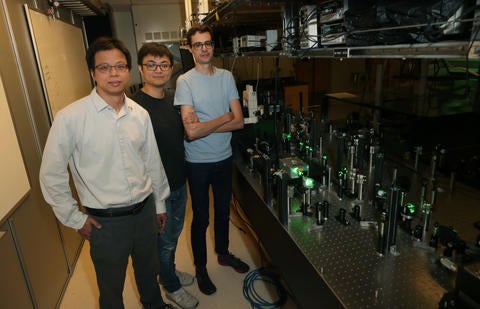An international research team led by scientists at the University of California, Riverside, has observed light emission from a new type of transition between electronic valleys, known as intervalley transmissions.
The research provides a new way to read out valley information, potentially leading to new types of devices.

Current semiconductor technology uses electronic charge or spin to store and process information; the associated technologies are called electronics and spintronics, respectively. Some semiconductors contain local energy valleys in their electron band structure that can be used to encode, process, and store information, giving rise to a new kind of technology called valleytronics.
“Valleytronics provides an alternative route to engineer information systems besides the conventional electronics and spintronics,” said Chun Hung “Joshua” Lui, an assistant professor in the Department of Physics and Astronomy at UC Riverside, who led the research on intervalley transitions in monolayer tungsten diselenide (WSe2). “Our new work can speed up the development of valleytronics.”
Monolayer WSe2 is a promising valleytronic material because it possesses two valleys with opposite dynamic characteristics in the band structure. Moreover, this material can interact strongly with light, holding promise for optically controllable valleytronic applications.
Excitons
When monolayer WSe2 absorbs a photon, a bound electron can be freed in a valley, leaving behind an electron vacancy, or hole. As the hole behaves like an electron with positive charge, the electron and hole can attract each other to form a bound state called an exciton. Such an exciton, with both its electron and hole in the same valley, is called an intravalley exciton. Current exciton research in monolayer valley semiconductors focuses predominantly on intravalley excitons, which can emit light.
An electron and a hole in opposite valleys can also form an exciton, called an intervalley exciton, which is a novel component in valleytronics. The law of momentum conservation, however, forbids an electron and a hole in opposite valleys from recombining directly to emit light. As a result, intervalley excitons are “dark” and hidden in the optical spectrum.
The UCR-led research team has now observed light emission from intervalley excitons in monolayer WSe2. The team found that although the intervalley excitons are intrinsically dark, they can emit a significant amount of light with the assistance of either defects or lattice vibrations in the material.
“The scattering with defects or lattice vibrations can compensate for the momentum mismatch between an electron and a hole in opposite valleys,” Lui said. “It allows us to observe the light emission of intervalley excitons.”
“Although the process involves scattering with defects or lattice vibrations, the intervalley light emission is circularly polarized,” said Erfu Liu, a postdoctoral researcher in Lui’s lab and the first author of the research paper. “Such circular light polarization allows us to identify the exciton valley configuration. This optically readable valley configuration is crucial to making intervalley excitons useful for valleytronic applications.”
Trions
Besides the excitons, monolayer WSe2 also hosts trions, which consist of two electrons and one hole or two holes and one electron. Trions also have well-defined valley configurations for valleytronic applications. Compared to the charge-neutral excitons, the motion of trions can be controlled by an electric field due to their net electrical charge.
A trion can generally decay through two paths. For example, for a trion consisting of an intravalley electron-hole pair and a hole in the opposite valley to decay, the electron can choose to recombine with the hole in the same valley or with the hole in the opposite valley. This gives rise to two different trion decay paths with intravalley and intervalley electron-hole recombination. The intravalley trion decay has been much studied, but the intervalley trion decay has not been reported thus far.
The UCR-led team has shown intervalley trion decay for the first time.
“Although a trion can decay through either intravalley or intervalley decay, the two transitions have the same energy and can hardly be distinguished in the optical spectrum,” Lui said. “But when a magnetic field is applied, the energies of the intravalley and intervalley transitions will become different.”
The team carried out the experiments at the National High Magnetic Field Laboratory in Tallahassee, Florida. They show both the intravalley and intervalley decay paths of the trions.
“Our results provide a more complete, multipath picture of trion dynamics in monolayer WSe2,” said Jeremiah van Baren, a graduate student in Lui’s lab, who shares equal authorship with Liu. “They build on the existing single-path description of trions in 2-D materials and are key to furthering trion-based valleytronic science and technology.”
The research paper, published in Physical Review Letters, is titled “Multipath optical recombination of intervalley dark excitons and trions in monolayer WSe2.” Related results were recently reported by two other research teams led by scientists at Rensselaer Polytechnic Institute and the University of Washington.
Lui, a recent recipient of the National Science Foundation’s prestigious Faculty Early Career Development (CAREER) Award; Liu, and van Baren were joined in the study by Nathaniel Gabor of UC Riverside; Ching-Tang Liang and Yia-Chung Chang of the Research Center for Applied Sciences at the Academia Sinica in Taipei, Taiwan; and Takashi Taniguchi and Kenji Watanabe of the National Institute for Materials Science in Tsukuba, Japan.
Header image caption: Intervalley exciton light emission from monolayer WSe2. Monolayer WSe2 consists of a two-dimensional array of tungsten atoms (cyan balls) and selenium atoms (yellow balls). Its conduction and valence energy bands exhibit two valleys with opposite electron spins (red and blue cups). An electron (green ball) and a hole (purple ball) in the opposite valleys can be bound to form an intervalley exciton (orange-yellow ellipsoid), which decays to emit light with circular polarization (red spiral). (UCR/Erfu Liu)